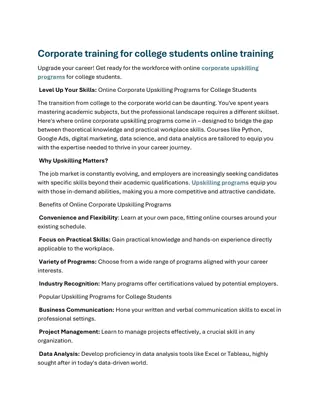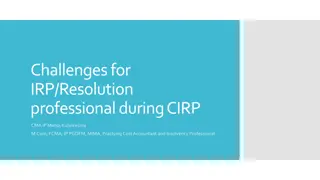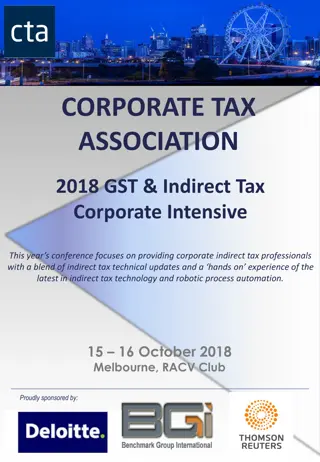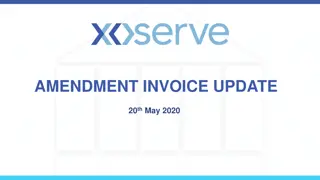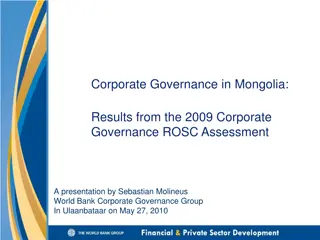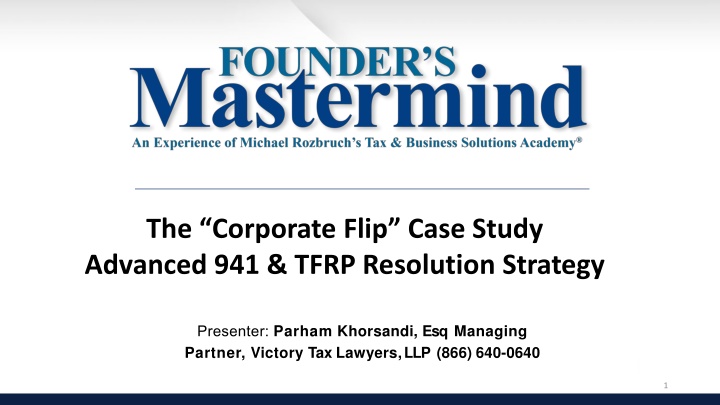
Advanced 941 & TFRP Resolution Strategy - A Case Study Presentation
Discover a case study on advising clients facing IRS shutdown due to financial constraints, along with steps to wrap up the old entity and transition to a new one successfully in the context of 941 payroll taxes and Trust Fund Recovery Penalty (TFRP).
Download Presentation

Please find below an Image/Link to download the presentation.
The content on the website is provided AS IS for your information and personal use only. It may not be sold, licensed, or shared on other websites without obtaining consent from the author. If you encounter any issues during the download, it is possible that the publisher has removed the file from their server.
You are allowed to download the files provided on this website for personal or commercial use, subject to the condition that they are used lawfully. All files are the property of their respective owners.
The content on the website is provided AS IS for your information and personal use only. It may not be sold, licensed, or shared on other websites without obtaining consent from the author.
E N D
Presentation Transcript
The Corporate Flip Case Study Advanced 941 & TFRP Resolution Strategy Presenter: Parham Khorsandi, Esq Managing Partner, Victory Tax Lawyers,LLP (866) 640-0640 1
941 Case Study What do you advise the client when operation of the client s company is no longer viable? For example, they not only do not have the funds to go on a monthly payment plan, but they also cannot stay current with their FTD s either. Essentially, they are being shut down by the IRS . 2
941 Case Study Facts: 1. The Company is an entity (S Corp/C Corp, Multimember LLC). It cannot be a single member LLC, disregarded entity. 2. Corporation owes $375,000 in 941 payroll taxes (all 941 s filed) 3. Trust Fund Recovery Penalty (TFRP) represents $263,000 of the $375,000 and is about to be assessed against the sole shareholder. 4. There is an aggressive Revenue Officer (RO) assigned to the case. 3
Part I: Wrapping up the Old Entity 1. Close Old Corporation by closing all bank accounts. Do not attempt to obtain a dissolution Certificate from the Secretary of State, unless all State payroll, sales and income taxes paid. 2. File final returns for the entity for both 1120/1120S and any 940 and 941 s, so that all filing requirements are closed out. 3. Address any existing assets. (slides 6,7 & 8) 4. Was the proper shareholder assessed the TFRP via 4180 Appeal the 1153 letter? 4
Part II: Forming New Entity and Transitioning Successfully 5.Form a new entity with a different address and phone number, etc. a. Cannot keep same address, phone number, or shareholder b. Needs new EIN and bank account c. If the name, address, or phone number are the same the IRS may attempt to use this to attach the debt of the old company to the new company via Alter Ego 5
Part II: Forming New Entity and Transitioning Successfully 6. Inform RO of your plan a. Notify the RO if the intent of the Taxpayer to close down the business and that you are taking the proper steps (cannot be a messy flip) b.If there is someone that is purchasing the assets of the business, then notify the RO, so that you can enlist his/her help to complete the sale and secure a lien discharge on the old business assets. Very important to get the lien discharge letter on the business assets so new buyer can have clean title. c. Make sure the RO understands that the old shareholder does not have any ownership interest/capacity, in New corporation or that there is any involvement in setting up the entity. 6
Part II: Forming New Entity and Transitioning Successfully 7. The new entity s shareholder must be someone other than your client. (not a spouse) a. Should be an arms-length transaction 8. New entity buys assets of old entity at liquidation value via a Buy/Sell Agreement 9. Execute a Promissory Note pursuant to the Buy/Sell Agreement a. Be sure that the new entity is purchasing the assets free of the lien. 7
Part II: Forming New Entity and Transitioning Successfully 10. All payments under the Promissory Note are considered voluntary and as such can be Designated Payments made toward the TFRP only. (thereby reducing your client s personal exposure) 11. IRS will 53 (Currently Not Collectible Defunct status) any balance remaining at the old corporate level ($375,000 - $263,000). So, your client can walk away from the business and only be have to address the personal TFRP portion. 8
Part II: Addressing the Civil Penalties / Personal Portion (i.e. Trust Fund Recovery Penalty) 12.Your client goes to work for new entity as a W-2 employee (does not have to be instantaneous) 13.Put them on payroll with a salary that is just enough to cover their allowable monthly expenses per IRS Collection Standards. 14.IRS will access the TFRP (CIVPEN of $263,000) to your client if they haven t already a. Consider waiving the appeal on 1153 period if you are ready to submit the OIC ASAP. This can save time. 9
Part II: Addressing the Civil Penalties / Personal Portion (i.e. Trust Fund Recovery Penalty) 15. Submit an OIC-Doubt as to Collectability (DATC) for $1,000 toward the $263,000 TFRP that was assessed against your client 16. IRS accepts the OIC as settlement in full (Offers taking 12-18 months) 17. Client gets a fresh start! 18. You re a HERO! (and earned your $35,000 fee!) 10
The Corporate Flip Advanced Resolution Strategy Pros: You can wipe out a substantial amount of liability if it works properly. Not only will the Corp be CNC d, but the client can OIC their personal liability. Cons: If you do not do this correctly, and follow the steps above, RO may claim alter ego entity. Meaning the business liability of the old entity will be transferred to the new entity. Not a good place to be. 11





